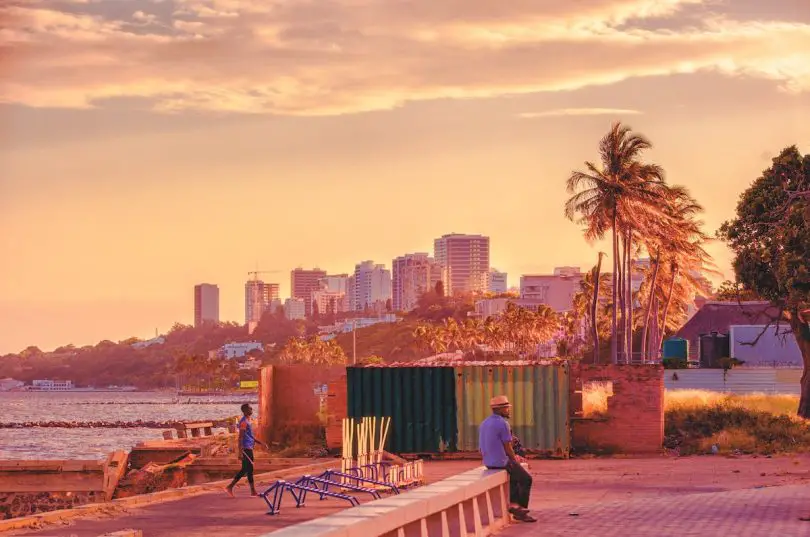The magnificence and allure of the coastline along the Indian Ocean is a compelling reason why you should visit Mozambique Africa.
The coastline is characteristic of calm islands and historic settlements. You can experience a safari on Niassa Reserve, traditional silversmithing on Ibo, and snorkelling amid colourful reef fish at Bazaruto.
You could also take in the Afro-Mediterranean flavour of Maputo’s bustling marketplaces; or relax on a stretch of uninhabited beach in the country’s coastal city.
Whatever plans and motivation you have for travelling down to Maputo, you will surely enjoy your stay for various reasons. Mozambique’s cuisine, music, and art reflect the region’s deep cultural roots.
The weather is perfect for vacationers thanks to its warm, tropical atmosphere. This South African country is a tourist’s dream thanks to its many attractions. Many beaches, marine parks, colonial-era ruins, and delicious seafood exist. The beautiful coastline and the stunning white sand beaches make it an ideal destination for those searching for relaxation and rejuvenation.
See Africa Today delves deep into why you should visit Mozambique Africa.

Mozambique Beach. Photo/Art of Safari
Table of Contents
Extensive Coastlines with Pristine Beaches
Mozambique has all the elements of a perfect tropical beach. White sand, azure water, and swaying palm trees. The country’s many beautiful beaches mostly drive Mozambican tourism.
Mozambique boasts a coastline of more than 2,500 kilometres along the lush Indian Ocean and dozens of lovely offshore islands. Diving, fishing, whale viewing, and birdwatching are reasons why you should visit Mozambique Africa
Even at the most developed resorts, the coastline remains largely untouched, so visitors enjoy virtually empty beaches that stretch for kilometres.
Cool Old Cities
Visitors visiting Mozambique should not miss the opportunity to experience the tranquillity and history of Inhambane. The coastline of Inhambane is one of the most popular tourist destinations due to its abundance of beautiful beaches. It has unending groves of towering coconut palms and excellent marine activities.
The island of Mozambique, the first European settlement on Africa’s eastern coast, is one of the world’s most fascinating and unusual places. Several of the earliest surviving structures in the southern hemisphere are in Mozambique Island. It’s a crescent-shaped island measuring roughly 3 kilometres from north to south and no more than 600 meters wide.
The village of Ibo, located on the island of Ibo, is one of the oldest towns in all of Mozambique. Travellers who make it to this fascinating town rave about their time spent exploring its worn streets. Chatting with the friendly locals is always a high point of their Mozambican adventure.
Welcoming National Parks

Gorongosa National Park. Photo/YouTube
Recent years have seen the improvement and opening of numerous national parks in Mozambique. The 5,250 km2 Gorongosa National Park was rehabilitated and is one of Africa’s finest safari locations.
Niassa Nature Reserve is the third largest wildlife refuge in Africa. It provides visitors with as close to a true unspoiled African bush experience as is possible in the modern era.
Canoeing down the river, past sputtering hippos, drinking elephants, and a splendid array of birds is completely enthralling. Guided game walks allow visitors to experience the thrill of the African bush, which is why you should visit Mozambique Africa.
Maputo’s Lively Cultural Scene

Maputo. Photo/African Budget Safaris
As Mozambique’s largest city, Maputo is and feels unique. The atmosphere in the streets and marketplaces is lively and upbeat. Drivers are generally polite and less frantic than in many other parts of Africa.
If you visit Maputo without any preconceived notions, you will find that it is, in fact, a really pleasant city. It’s safe as any other African city and boasts significantly more charm and personality than most of its contemporaries.
The avenidas have a laid-back, unhurried, Afro-Mediterranean vibe that is uniquely Mozambican. The jacaranda, flame, and palm trees that line them up support the abundance of street cafés. Charming historic colonial structures surround them in varying stages of repair or decay.
But it still gives the sense that this city has both a rich past and a promising future. That’s why you should visit Mozambique Africa.
The Waters of Niassa Lake
Lago Niassa, often known as Lake Malawi, is the third-largest lake in Africa and the ninth-largest lake in the world. It stretches 585 kilometres from north to south and can be as wide as 75 kilometres from east to west.
Located at the southern end of the Rift Valley, the lake is truly spectacular. It reaches depths of up to 700 meters and is surrounded by the towering mountains of the Rift Valley escarpment.
Thanks to its crystal-clear water and low pollution levels, it supports more fish species than any other lake on earth. This includes hundreds of endemic cichlids.








